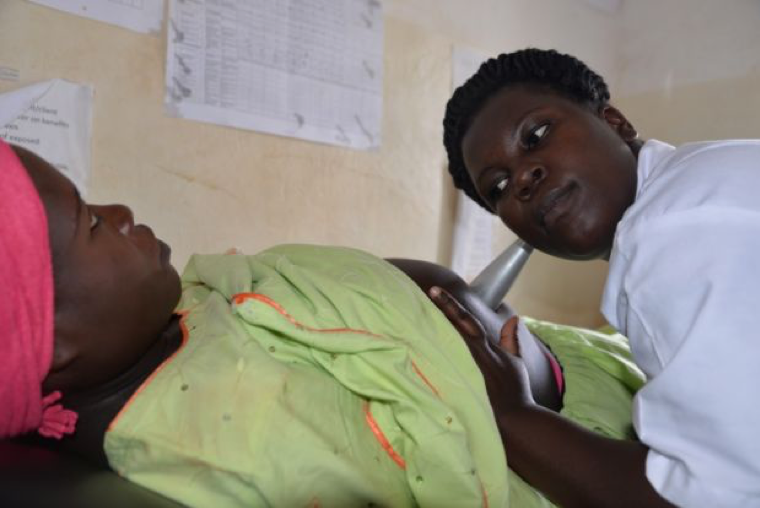Traditional birth attendant graduates to community health worker and best practice champion

Florence Auma Agoola, 60, had been a traditional birth attendant for more than 30 years. Although she does not recall the exact number of deliveries she handled in the three decades, she estimates the number to be between 300 and 400 without single mortality.
“Every month I delivered at least a baby or two. It is a blessing that no child or mother has ever died at my hands,” Florence says, she gestures with her hands in praise of God.
Florence’s story

The year was 1989 when Florence was invited to help a neighbour in labour pain. She had never handled a delivery before but had keenly observed her auntie do it several times with success. With the nearest hospital located 10 kilometres away, no ambulance, or a trained health worker, Florence helped the mother to deliver. That first successful delivery established her as a reliable traditional birth attendant.
“I couldn’t imagine that without any formal training and proper equipment I had helped a mother deliver a baby. I solely relied on traditional techniques that I had observed my auntie apply, and they worked miracles,” she says.
The art of improvisation is when the best is not available and the available becomes the best. That was the case for Florence. When she lacked gloves, she used polythene bags: “It was all about improvising,” Florence recalls. “I didn’t have razor blades, and so I used the sharp edge of sorghum stems to cut the umbilical cord.”
To stop the bleeding, Florence mixed millet flour in water and got women to drink; stopping the bleeding instantly. And when the placenta got retained, she used a simple technique of splashing cold water onto the cervix and ‘expertly’ moved her fingers around to cause the mother to clench her abdomen.
In many rural communities of Uganda, it is common knowledge that traditional birth attendants are more trusted and respected by mothers because they are friendly and are close enough in the neighbourhood to help. Over 30 years, Florence was an alternative to many rural women who could not access health services.
Change happens
In 2011, World Vision saw an opportunity to provide traditional birth attendants with professional skills. Working with the Ministry of Health, World Vision trained community health workers to support pregnant women and their babies throughout their pregnancy and for the first two years of a child's life.
Florence was in the first batch of trainees. She was trained to counsel pregnant women and mothers of young children on the importance of good health and nutrition. She also learned to provide useful tips for pregnancy and during the first two years of a child’s life: “We were trained on how to recognise the danger signs and make referrals,” she says. “We were also cautioned on the dangers of some of the traditional techniques we were using before such as inserting a stick into women to induce labour pains.”
Safer deliveries

Edith Nabwire Oundo, 38, gave birth to her first child, Rachel, at home with Florence’s help. When she called Florence during her second pregnancy, she was advised to go to the health facility: “I trusted Florence. When she advised me to find her at the hospital, I followed her advice. When I saw her I felt very comfortable, and ever since, I have delivered all my other children here [at the health facility],” says Edith.
Sarah Lilian Namukanja, 31, who has been a midwife at Lunyo Health Centre for four years, says integrating people like Florence into the official health system has made a major difference. She says:
Traditional birth attendants are trusted and respected in our communities. Bringing them on board is the best thing that has ever happened to our health system to ensure the continuum of health services.
Mothers are also adhering to post-natal care for their children. Sarah says numbers of children being immunised are increasing and so are visits to the health centres and hospitals: “Before we would have about 16 deliveries a month. However, when the birth attendants got involved and trained into community health workers, we started witnessing over 80 deliveries a month. Now there are over 120 in a month on average for the past two years,” she adds.
“Traditional birth attendants are now acting as a pulling factor and a bridge between us [health workers] and the community,” says Sarah. “They are providing the much-needed support, guidance and advice at critical times.”
World Vision’s commitment
World Vision is committed to promoting effective health and nutrition programmes, and believes that access to basic health healthcare is essential to breaking the cycle of maternal and child mortality through the AIM Health Plus programme.
The five-year programme, in partnership with Irish Aid, now in its second phase; running until 2021. The target is to reduce neonatal and child deaths by 20% and maternal deaths by 15% in areas where World Vision has maternal and child health interventions. Current progress trends indicate a reduction of 4% of child mortality rates within one and a half years.
In Uganda, it is estimated that 16 women die every day from pregnancy and childbirth-related causes, 94 babies are stillborn and 81 new-born babies die. This equates to 69,570 deaths each year; many of which are largely preventable.
Since 2011, over 2,000 Community Health Workers have been trained to:
- Visit pregnant women and new mothers in their homes and provide them with support, guidance and advice at critical times, using World Vision’s Timed and Targeted Counselling approach
- Support pregnant women and new mothers to attend their check-ups
- Advise on how to ensure both mother and baby eat nutritious food
- Encourage and support immunisation
- Get men involved; - help husbands and extended family to play their role in ensuring both mother and baby are as safe and healthy as possible
-----
Story by Fred Ouma, Development Communications Coordinator, World Vision Uganda